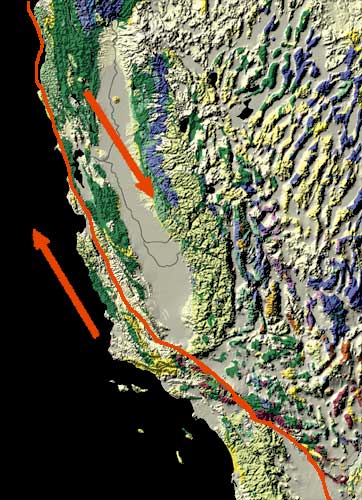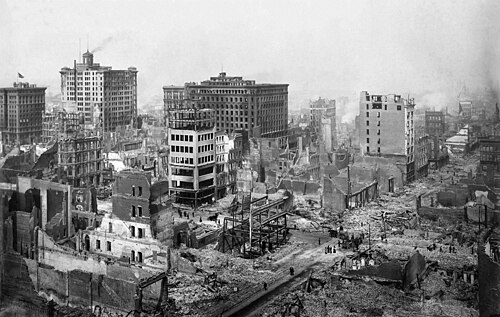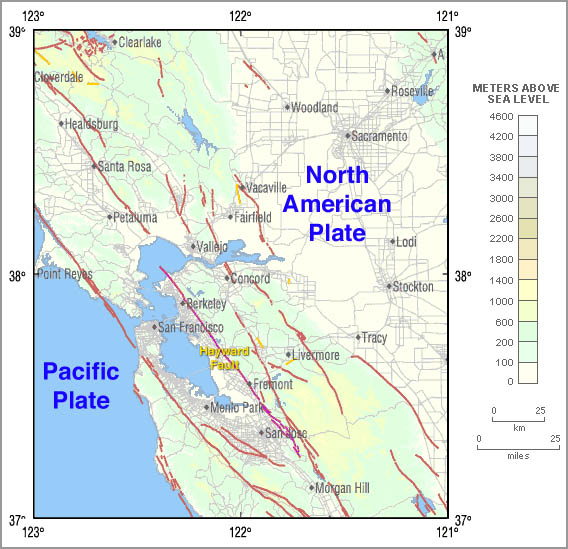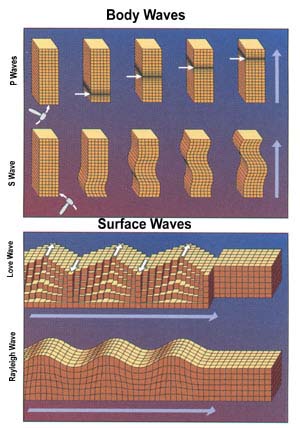High School Earth Science/Nature of Earthquakes
An earthquake is sudden ground movement caused by the sudden release of energy stored in rocks. The earthquake happens when so much stress builds up in the rocks that the rocks rupture. An earthquake's energy is transmitted by seismic waves. Each year there are more than 150,000 earthquakes strong enough to be felt by people and 900,000 recorded by seismometers.
Lesson Objectives
[edit | edit source]- Be able to identify an earthquake focus and its epicenter.
- Identify earthquake zones and what makes some regions prone to earthquakes.
- Compare the characteristics of the different types of seismic waves.
- Describe how tsunamis are caused by earthquakes, particularly using the 2004 Boxing Day Tsunami as an example.
Causes of Earthquakes
[edit | edit source]Almost all earthquakes occur at plate boundaries. All three boundary types—divergent, convergent and transform—are prone to earthquake activity. Plate tectonics causes the lithospheric plates to move. As you might imagine, having giant slabs of lithosphere moving about on a spherical shape is not smooth. When stresses build, they first cause the rocks to bend elastically. If the stresses persist, energy continues to build in the rocks. When the stresses are greater than the internal strength of the rocks, the rocks snap. Although they return to their original shape, the stresses cause the rocks to move to a new position. This movement releases the energy that was stored in the rocks, which creates an earthquake. During an earthquake the rocks usually move several centimeters or maybe as much as a few meters. This description of how earthquakes occur is called elastic rebound theory (Figure 7.25).

The point where the rock ruptures is usually below the Earth’s surface. The point of rupture is called the earthquake's focus. The focus of an earthquake can be shallow - less than 70 kilometers (45 miles), intermediate - 70 to 300 kilometers (45 to 200 miles), or deep - greater than 300 kilometers (200 miles). About 75% of earthquakes have a focus in the top 10 to 15 kilometers (6 to 9 miles) of the crust. Shallow earthquakes cause the most damage because the focus is near the Earth's surface where people live.
Just above the focus on the land surface is the earthquake's epicenter (Figure 7.26). It is the epicenter of an earthquake that is reported by scientists and the media. The epicenter of the 1906 San Francisco earthquake, for example, was offshore, 1.5-3 kilometers (1-2 miles) west of Golden Gate Park.

Earthquake Zones
[edit | edit source]Some locations are prone to earthquakes and some are not. Nearly 95% of all earthquakes take place along one of the three types of plate boundaries. Scientists use the location of earthquake epicenters to draw the boundaries of the plates because earthquakes frequently occur along plate boundaries (Figure 7.27).

The region of the planet with the most earthquakes is the area around the Pacific Ocean. About 80% of all earthquakes strike this area. This region is called the Pacific Ring of Fire because most volcanic eruptions occur there as well. The Pacific Ocean is surrounded by convergent and transform plate boundaries (Figure 7.28).


About 15% of all earthquakes take place in the Mediterranean-Asiatic belt. This is where convergent plate boundaries are shrinking the Mediterranean Sea and causing the Himalayas to grow. The remaining 5% of earthquakes are scattered around the other plate boundaries with a few occurring in the middle of a plate, away from plate boundaries.
All three types of plate boundaries have earthquakes. Enormous and deadly earthquakes occur at transform plate boundaries. Because the slabs of lithosphere slide past each other without moving up or down, transform faults have shallow focus earthquakes. The most notorious earthquake fault in North America is the San Andreas Fault that runs through California. The 1,300 kilometer (800 mile) long fault is the transform boundary between the northwestward-moving Pacific plate and the southeastward-moving North American plate. The San Andreas Fault is a right-lateral strike-slip fault (Figure 7.29).
The largest earthquake on the San Andreas Fault in historic times occurred in 1906 in San Francisco (Figure 7.30). This earthquake likely measured magnitude 7.8, which is a very large earthquake. The earthquake and the subsequent fire is still the most costly natural disaster in California history. An estimated 3,000 people died and about 28,000 buildings were lost, mostly in the fire.

In 1989, the Loma Prieta earthquake struck near Santa Cruz, California. The magnitude 7.1 quake resulted in 63 deaths, 3,756 injuries and left more than 12,000 people homeless. The property damage was estimated at about $6 billion. In 1994, an earthquake on a blind thrust fault struck near Los Angeles, California in the neighborhood of Northridge. It registered 6.7 on the moment magnitude scale. Seventy two people died, 12,000 more were injured and damage was estimated at $12.5 billion.
There are many other faults spreading off the San Andreas Fault, which together with the main fault produce around 10,000 earthquakes a year (Figure 7.31). While most of those earthquakes cannot even be felt by people nearby, occasionally one is massive. In the San Francisco Bay Area, the Hayward Fault was the site of a magnitude 7.0 earthquake in 1868.

Convergent plate boundaries also produce massive and deadly earthquakes. Earthquakes mark the motions of subducting lithosphere as it plunges through the mantle. The earthquakes can be shallow, intermediate or deep focus. Convergent plate boundaries produce earthquakes all around the Pacific Ocean basin.
The Philippine plate and the Pacific plate subduct beneath Japan creating a chain of volcanoes and as many as 1,500 annual earthquakes. The great Kanto earthquake of 1923 is thought to have killed 140,000 people, many in the subsequent fire. In Yokohama, 90% of houses were damaged or destroyed and 60% of Tokyo's population became homeless. In the Great Hanshin (Kobe) Earthquake of 1995, 6,434 people died (Figure 7.32).

Subduction is also taking place along the Cascades Mountains in the Pacific Northwest as part of the Pacific Ring of Fire. The Juan de Fuca plate is plunging beneath the North American plate and forming volcanoes that extend south into northern California. The Cascades volcanoes are active and include Mount Saint Helens, which had a large eruption in 1980. Mount Lassen, Mount Shasta, and Medicine Lake volcano in northeastern California are the three southernmost volcanoes in the Cascades chain.
Yet the Cascadia subduction zone is one of the world's quietest subduction zones, with relatively few earthquakes. Though they don't happen often, they are extremely powerful when they hit. The last major earthquake on the Juan de Fuca occurred in 1700, with a magnitude estimated at between 8.7 and 9.2. The geologic history of the area reveals that major earthquakes occur here about every 300 to 600 years. Since it has now been more than 300 years since the last earthquake in the area, the Pacific Northwest is at risk from a potentially massive earthquake that could strike any time.
The thrust faulting and folding that result from the convergence of continental plates creates massive earthquakes. The region in and around the Himalaya, for example, is the site of many earthquakes. The 2001 Gujarat, India earthquake is responsible for about 20,000 deaths with many more people injured or made homeless.
Earthquakes also occur at divergent plate boundaries. At mid-ocean ridges, these earthquakes tend to be small because the plates are young and hot. The earthquakes are shallow because the new plates are thin. Since divergent plate boundaries in the oceans are usually far from land, they have little effect on peoples' lives. On land, where continents are rifting apart, earthquakes are larger and stronger.
About 5% of earthquakes take place within a plate; that is, away from plate boundaries. A large intraplate earthquake occurred in 1812 when a magnitude 7.5 earthquake struck near New Madrid, Missouri. The earthquake was strongly felt over around 50,000 square miles, and altered the course of the Mississippi River. Because very few people lived here at the time, only 20 people died. However many more people live here today and the New Madrid Seismic Zone continues to be active (Figure 7.33). A similar earthquake today would undoubtedly kill many people and cause a great deal of property damage. Intraplate earthquakes are caused by stresses due to plate motions acting in solid slabs of lithosphere.

Seismic Waves
[edit | edit source]Energy is transmitted in waves. Every wave has a high point called a crest and a low point called a trough. The height of a wave from the center line to its crest is its amplitude. The distance between waves from crest to crest (or trough to trough) is its wavelength (Figure 7.34).

The energy from earthquakes (and also from explosions) travels in waves called seismic waves. Other types of waves transmit other types of energy; for example, sound waves transmit a child's laughter and other sounds. The study of seismic waves is known as seismology. Seismologists use seismic waves to learn about earthquakes and also about the Earth's interior.
Seismic waves move outward in all directions away from their source. There are two major types of seismic waves. Body waves travel through the solid body of the Earth from the earthquake's focus throughout the Earth's interior and to the surface. Surface waves just travel along the ground surface. The different types of seismic waves travel at different speeds in different materials. All seismic waves travel through rock, but not all travel through liquid or gas. In an earthquake, body waves are responsible for sharp jolts. Surface waves are responsible for rolling motions. Surface waves do most of the damage in an earthquake.
Body Waves
[edit | edit source]
There are two types of body waves – primary waves (P-waves) and secondary waves (S-waves). These waves travel through the Earth's interior. P-waves are the fastest at about 6 to 7 kilometers (about 4 miles) per second. They are named primary waves because they are the first waves to reach a seismometer. S-waves are slower and so are the second waves to reach a seismometer. Body waves move at different speeds depending on the type of material they are passing through.
P-waves are longitudinal waves. They move material forward and backward in the same direction that they are traveling. This motion resembles a spring squeezing and unsqueezing. The material returns to its original size and shape after the P-wave goes by. For this reason, P-waves are not the most damaging earthquake waves. P waves can travel through solids, liquids and gases.
S-waves are transverse waves, that move up and down. Their oscillations are perpendicular to the direction the wave is traveling. In a rock, this motion produces shear stresses. S-waves are about half as fast as P-waves, traveling at about 3.5 km (2 miles) per second. S-waves can only move through solids because liquids and gases have no shear strength.
Surface Waves
[edit | edit source]Surface waves travel along the ground outward from an earthquake's epicenter. Surface waves are the slowest of all seismic waves, traveling at 2.5 km (1.5 miles) per second. There are two types of surface waves. Love waves move side-to-side much like a snake. Rayleigh waves move in rolls, like ocean swells (Figure 7.35). These waves cause objects to fall and rise, while swaying back and forth. These motions cause damage to rigid structures during an earthquake.
Tsunami
[edit | edit source]Earthquakes can cause deadly ocean waves called tsunami, although tsunami can be caused by any shock to ocean water, including a meteorite impact, landslide, or a nuclear explosion. When ocean water is displaced by the sharp jolt of an undersea earthquake, the seismic energy forms a set of waves. The waves travel through the sea entirely unnoticed since they have low amplitudes and long wavelengths. When these waves come onto shore, they can grow to enormous heights and cause tremendous destruction and loss of life. Fortunately, few undersea earthquakes generate tsunamis.
The Boxing Day Tsunami of December 26, 2004 was by far the deadliest of all time. The tsunami was caused by the 2004 Indian Ocean Earthquake, also called the Great Sumatra-Andaman earthquake (Figure 7.36). This earthquake, with a magnitude of 9.2, was the second largest earthquake ever recorded. The energy that reached the planet's surface was 1,502 times the amount released by the atomic bomb dropped on Hiroshima, but the total amount of energy released was estimated at 550 million times Hiroshima.

The Indian Ocean Earthquake struck 160 kilometers (100 miles) off of Sumatra, Indonesia. In this region the Indian plate is subducting beneath the Burma plate. Slip along the earthquake fault was an incredible 15 meters (50 feet), about two-thirds of that in a horizontal direction and one-third in a vertical direction. The fault ruptured over about 1,600 kilometers (1,000 miles). Faulting went on for up to 10 minutes, the longest duration ever witnessed.
The extreme movement of the crust displaced trillions of tons of water. Water displacement occurred along the entire length of the rupture. This means that tsunami waves formed along a great distance, which increased the area that the killer waves traveled to. Several tsunami were created, with about 30 minutes between the peaks of each one.
The water traveled rapidly across the Indian Ocean outward from the fault. As is typical for tsunami, the waves were not noticeable in open water. Satellites measured the height of the waves across the sea at just 50 centimeters (20"). The first wave hit the northern regions of Sumatra in about 15 minutes. At its worst, the waves rose to around 10 meters (33 feet) in height. Within 1.5 to 2 hours, waves were striking Sri Lanka and the eastern coast of India. Thailand was battered two hours after the earthquake. Somalia was hit seven hours after the earthquake. The size of the waves decreased with distance from the earthquake so that the waves in Sri Lanka, Thailand, and Somalia were relatively small, about 4 meters (13 feet) in height.
Like other waves, a tsunami wave has a crest and a trough. What people see when the tsunami hits the beach depends on whether the crest or the trough hits first. In some locations, the trough of the wave hit the beach first. When this happens, water is sucked out to sea and the seafloor just offshore from the beach is exposed. Curiosity is often fatal in this instance, since people who go out to the beach to see the unusual sight are drowned when the wave crest hits.
One amazing story was that of Tilly Smith, a 10 year old British girl who was visiting Maikhao Beach in Thailand with her parents. About two weeks before the earthquake, Tilly had learned about tsunamis in school. She knew that the receding water and the frothy bubbles at the sea surface indicated an approaching tsunami. As the trough of the tsunami wave hit the beach, she pointed these features out to her parents. They told other tourists and the staff at their hotel and the beach was evacuated. No one on Maikhao Beach died and Tilly is credited with saving nearly 100 people.
On other beaches, people were not so lucky. In all, the tsunami struck eight countries, with Indonesia, Sri Lanka, India and Thailand the hardest hit (Figure 7.37). About 230,000 people died, with fatalities even as far away as South Africa, nearly 8,000 kilometers (5,000 miles) from the earthquake epicenter. More than 1.2 million people lost their homes and many more lost their ways of making a living. For example, fishermen lost their boats, and business people lost their restaurants and shops. Many marine animals were washed inland, including dolphins, turtles, and sharks.

Only a few scientists had thought that a massive tsunami would strike the Indian Ocean so no warning system had been in place. Tsunami are much more common in the Pacific due to the enormous number of subduction zones that line the Pacific basin, and communities around the Pacific have had a tsunami warning system in operation since 1948 (Figure 7.38). As a result of the 2004 tsunami, an Indian Ocean warning system was put into operation in June 2006.

Warning systems are of limited use. They base their warnings on the location of earthquakes within an ocean basin. Unfortunately, communities that are very close to the earthquake do not receive the warning in time to move inland or uphill since the wave hits too fast. Still evacuation of low-lying areas could save many people in a large tsunami that is further from the earthquake.
Lesson Summary
[edit | edit source]- During an earthquake, the ground shakes releasing stored up energy from rocks. Nearly all earthquakes occur at plate tectonic boundaries and all types of plate boundaries have earthquakes.
- The Pacific Ocean basin and the Mediterranean-Asiatic belt are the two geographic regions most likely to experience quakes. The seismic waves that do the most damage are surface waves, which only travel along the surface of the ground.
- Body waves travel through the planet and arrive at seismograms before surface waves. Tsunamis are deadly ocean waves that can be caused by undersea earthquakes.
Review Questions
[edit | edit source]- What is an earthquake's focus? What is its epicenter?
- Why do most earthquakes take place along plate boundaries?
- Using elastic rebound theory, describe what triggers an earthquake.
- Use plate tectonics theory to describe why there are far more earthquakes around the Pacific Ocean than anywhere else on Earth.
- Since intraplate earthquakes are not near plate boundaries, give a general idea of what you think might cause them.
- Do the largest earthquakes cause the most deaths and the most damage to property?
- California is famous for earthquakes along the San Andreas Fault zone but there is another type of plate boundary where large earthquakes occur. What type of plate boundary is it and where are the earthquakes likely to occur?
- Using what you know about plate tectonics and elastic rebound theory, describe what is taking place in the Cascades Mountains of the Pacific Northwest, including northern California. What is likely to occur in the future? Include earthquakes and tsunamis.
- What type of faulting is found where two slabs of continental lithosphere are converging? Explain what this would look like on a diagram of the faults and the rocks on either side.
- What are the characteristics of body waves? What are the two types?
- What materials can P-waves travel through and how fast are they? Describe a P-wave's motion.
- What materials can S-waves travel through and how fast are they? Describe an S-wave's motion.
- How are surface waves different from body waves? In general, which type of waves is more damaging in an earthquake?
- What did Tilly Smith notice on the beach in Thailand that caused the adults around her to evacuate the beach before the enormous tsunami hit in 2004? How were these signs evidence of a tsunami?
Vocabulary
[edit | edit source]- amplitude
- The height of a wave from a center line to the top of the crest (or to the bottom of the trough).
- body waves
- A type of seismic wave that travels through the body of a planet. The two types are primary waves and secondary waves.
- crest
- The highest point of a wave.
- earthquake
- Ground shaking caused by the release of energy stored in rocks.
- elastic rebound theory
- The theory of how earthquakes are generated. Elastic rebound theory states that stresses cause strain to build up in rocks until they can no longer bend elastically and they break, causing an earthquake.
- epicenter
- The point on the earth's surface that lies above an earthquake's focus.
- focus
- The point where rocks rupture during an earthquake.
- Love waves
- These surface waves have a side-to-side motion, much like a slithering snake.
- primary waves (P-waves)
- P-waves are body waves that are the first to arrive at a seismometer because they are the fastest. P-waves are longitudinal waves that travel through solids, liquids, and gases.
- Rayleigh waves
- These surface waves have a rolling motion.
- secondary waves (S-waves)
- S-waves are body waves that are the second to arrive at a seismometer. S-waves are transverse waves that can only move through solids.
- seismic waves
- Seismic waves transport the energy released during an earthquake. The two main types are body waves and surface waves.
- seismology
- The study of seismic waves including earthquakes and the earth's interior.
- surface waves
- Surface waves are seismic waves that travel along the ground surface. The two types are Love waves and Rayleigh waves. Surface waves do the most damage after an earthquake.
- trough
- The lowest point of a wave.
- tsunami
- A deadly set of waves that are ordinarily caused by an undersea earthquakes or another shock in which large amounts of seawater are displaced. Tsunamis rise high on a beach and can travel far inland, causing death and destruction as they go.
- wavelength
- The distance from crest to crest or trough to trough between two waves.
Points to Consider
[edit | edit source]- The last time there was a large earthquake on the Hayward Fault in the San Francisco Bay area of California was in 1868. Use elastic rebound theory to describe what may be happening along the Hayward Fault today and what will likely happen in the future.
- Why is California so prone to earthquakes?
- How could coastal California be damaged by a tsunami? Where would the earthquake occur? How could such a tsunami be predicted?
